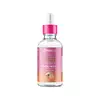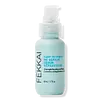What's inside
What's inside
 Benefits
Benefits

 Concerns
Concerns

 Ingredients Side-by-side
Ingredients Side-by-side

Water
Skin ConditioningHydrolyzed Collagen
EmollientHydrogenated Castor Oil/Sebacic Acid Copolymer
EmollientPolyquaternium-6
Oryza Sativa Bran Water
MaskingBrassica Campestris Seed Oil
Skin ConditioningCitrus Junos Peel Extract
Skin ConditioningPolyglyceryl-3 Diisostearate
EmulsifyingHydroxyethylcellulose
Emulsion StabilisingOleth-20
CleansingAdansonia Digitata Seed Oil
EmollientRosmarinus Officinalis Leaf Oil
MaskingCocos Nucifera Oil
MaskingPrunus Amygdalus Dulcis Oil
Skin ConditioningVitis Vinifera Seed Oil
EmollientDisodium EDTA
Phenoxyethanol
PreservativeBenzoic Acid
MaskingEthylhexylglycerin
Skin ConditioningGlycereth-2 Cocoate
EmulsifyingParfum
MaskingWater, Hydrolyzed Collagen, Hydrogenated Castor Oil/Sebacic Acid Copolymer, Polyquaternium-6, Oryza Sativa Bran Water, Brassica Campestris Seed Oil, Citrus Junos Peel Extract, Polyglyceryl-3 Diisostearate, Hydroxyethylcellulose, Oleth-20, Adansonia Digitata Seed Oil, Rosmarinus Officinalis Leaf Oil, Cocos Nucifera Oil, Prunus Amygdalus Dulcis Oil, Vitis Vinifera Seed Oil, Disodium EDTA, Phenoxyethanol, Benzoic Acid, Ethylhexylglycerin, Glycereth-2 Cocoate, Parfum
Water
Skin ConditioningGlycerin
HumectantGlyceryl Stearate
EmollientSqualane
EmollientCocos Nucifera Oil
MaskingSimmondsia Chinensis Seed Oil
EmollientCarthamus Tinctorius Seed Oil
MaskingVitis Vinifera Seed Oil
EmollientRicinus Communis Seed Oil
MaskingPhenoxyethanol
PreservativeCetearyl Alcohol
EmollientButylene Glycol
HumectantStearic Acid
CleansingPCA Dimethicone
Skin ConditioningXanthan Gum
EmulsifyingArginine
MaskingEthylhexylglycerin
Skin ConditioningSodium Lauroyl Glutamate
Acrylates/C10-30 Alkyl Acrylate Crosspolymer
Emulsion StabilisingSodium Acrylate/Sodium Acryloyldimethyl Taurate Copolymer
Emulsion StabilisingSodium PCA
HumectantAminomethyl Propanol
BufferingSodium Lactate
BufferingIsohexadecane
EmollientDisodium PEG-12 Dimethicone Sulfosuccinate
CleansingPentylene Glycol
Skin ConditioningPropanediol
SolventAspartic Acid
MaskingCaprylyl Glycol
EmollientPCA
HumectantPolysorbate 80
EmulsifyingGlycine
BufferingSorbitan Oleate
EmulsifyingAlanine
MaskingSerine
MaskingValine
MaskingIsostearyl Isostearate
EmollientIsoleucine
Skin ConditioningPanthenol
Skin ConditioningProline
Skin ConditioningThreonine
Cetearyl Glucoside
EmulsifyingHistidine
HumectantPhenylalanine
MaskingHydroxypropyl Guar
Emulsion StabilisingPhenethyl Alcohol
MaskingButyrospermum Parkii Butter
Skin ConditioningGlucose
HumectantCitric Acid
BufferingCoumarin
PerfumingLimonene
PerfumingAcetyl Cedrene
Alpha-Isomethyl Ionone
PerfumingBenzaldehyde
MaskingCitrus Aurantium Peel Oil
Dimethyl Phenylethyl Carbinyl Acetate
PerfumingHexamethylindanopyran
MaskingVanillin
MaskingParfum
MaskingWater, Glycerin, Glyceryl Stearate, Squalane, Cocos Nucifera Oil, Simmondsia Chinensis Seed Oil, Carthamus Tinctorius Seed Oil, Vitis Vinifera Seed Oil, Ricinus Communis Seed Oil, Phenoxyethanol, Cetearyl Alcohol, Butylene Glycol, Stearic Acid, PCA Dimethicone, Xanthan Gum, Arginine, Ethylhexylglycerin, Sodium Lauroyl Glutamate, Acrylates/C10-30 Alkyl Acrylate Crosspolymer, Sodium Acrylate/Sodium Acryloyldimethyl Taurate Copolymer, Sodium PCA, Aminomethyl Propanol, Sodium Lactate, Isohexadecane, Disodium PEG-12 Dimethicone Sulfosuccinate, Pentylene Glycol, Propanediol, Aspartic Acid, Caprylyl Glycol, PCA, Polysorbate 80, Glycine, Sorbitan Oleate, Alanine, Serine, Valine, Isostearyl Isostearate, Isoleucine, Panthenol, Proline, Threonine, Cetearyl Glucoside, Histidine, Phenylalanine, Hydroxypropyl Guar, Phenethyl Alcohol, Butyrospermum Parkii Butter, Glucose, Citric Acid, Coumarin, Limonene, Acetyl Cedrene, Alpha-Isomethyl Ionone, Benzaldehyde, Citrus Aurantium Peel Oil, Dimethyl Phenylethyl Carbinyl Acetate, Hexamethylindanopyran, Vanillin, Parfum
Alternatives
Ingredients Explained
These ingredients are found in both products.
Ingredients higher up in an ingredient list are typically present in a larger amount.
Cocos Nucifera Oil is obtained from the kernels of the coconut fruit. In other words, this is coconut oil.
Coconut Oil is rich in fatty acids with lauric acid making up the majority of these. It also contains linoleic acid. Due to this high fatty acid content, coconut oil helps trap moisture and soften skin.
Despite being antibacterial, coconut oil may not be great for acne-prone skin. It is comedogenic and may clog pores. This ingredient may not be safe for malassezia or fungal acne.
Note: Coconut Oil should not replace your sunscreen for UV protection. Studies show it only blocks about 20% of UV.
This oil is non-volatile and has a light scent.
The term 'fragrance' is not regulated in many countries. In many cases, it is up to the brand to define this term. For instance, many brands choose to label themselves as "fragrance-free" because they are not using synthetic fragrances. However, their products may still contain ingredients such as essential oils that are considered a fragrance.
Learn more about Cocos Nucifera OilEthylhexylglycerin (we can't pronounce this either) is commonly used as a preservative and skin softener. It is derived from glyceryl.
You might see Ethylhexylglycerin often paired with other preservatives such as phenoxyethanol. Ethylhexylglycerin has been found to increase the effectiveness of these other preservatives.
Parfum is a catch-all term for an ingredient or more that is used to give a scent to products.
Also called "fragrance", this ingredient can be a blend of hundreds of chemicals or plant oils. This means every product with "fragrance" or "parfum" in the ingredients list is a different mixture.
For instance, Habanolide is a proprietary trade name for a specific aroma chemical. When used as a fragrance ingredient in cosmetics, most aroma chemicals fall under the broad labeling category of “FRAGRANCE” or “PARFUM” according to EU and US regulations.
The term 'parfum' or 'fragrance' is not regulated in many countries. In many cases, it is up to the brand to define this term.
For instance, many brands choose to label themselves as "fragrance-free" because they are not using synthetic fragrances. However, their products may still contain ingredients such as essential oils that are considered a fragrance by INCI standards.
One example is Calendula flower extract. Calendula is an essential oil that still imparts a scent or 'fragrance'.
Depending on the blend, the ingredients in the mixture can cause allergies and sensitivities on the skin. Some ingredients that are known EU allergens include linalool and citronellol.
Parfum can also be used to mask or cover an unpleasant scent.
The bottom line is: not all fragrances/parfum/ingredients are created equally. If you are worried about fragrances, we recommend taking a closer look at an ingredient. And of course, we always recommend speaking with a professional.
Learn more about ParfumPhenoxyethanol is a preservative that has germicide, antimicrobial, and aromatic properties. Studies show that phenoxyethanol can prevent microbial growth. By itself, it has a scent that is similar to that of a rose.
It's often used in formulations along with Caprylyl Glycol to preserve the shelf life of products.
Vitis Vinifera Seed Oil comes from the grape vine. Grape seeds are a byproduct of creating grape juice or wine.
The components of grape seeds have many skin benefits. Research has found it to be antimicrobial and anti-inflammatory. It also contains many potent antioxidants such as Vitamin E , Vitamin C, proanthocyanidins, polyphenols, flavonoids, and anthocyanins. Proanthocyanidin has been shown to help even out skin tone.
Antioxidants help fight free-radical molecules. Free-radical molecules are capable of damaging our cells and other genetic material. Antioxidants help stabilize free-radicals by donating extra electrons. Grape seed extract may help reduce the signs of aging.
The antimicrobial properties of grape seed may help treat acne. However, more research is needed to support this claim.
Grape seed has also been found to help absorb UV rays. Grape seed extract should not replace your sunscreen.
The fatty acids of grape seed oil give it emollient properties. Emollients help soothe and soften your skin by creating a film. This film traps moisture within, keeping your skin hydrated.
Learn more about Vitis Vinifera Seed OilWater. It's the most common cosmetic ingredient of all. You'll usually see it at the top of ingredient lists, meaning that it makes up the largest part of the product.
So why is it so popular? Water most often acts as a solvent - this means that it helps dissolve other ingredients into the formulation.
You'll also recognize water as that liquid we all need to stay alive. If you see this, drink a glass of water. Stay hydrated!
Learn more about Water